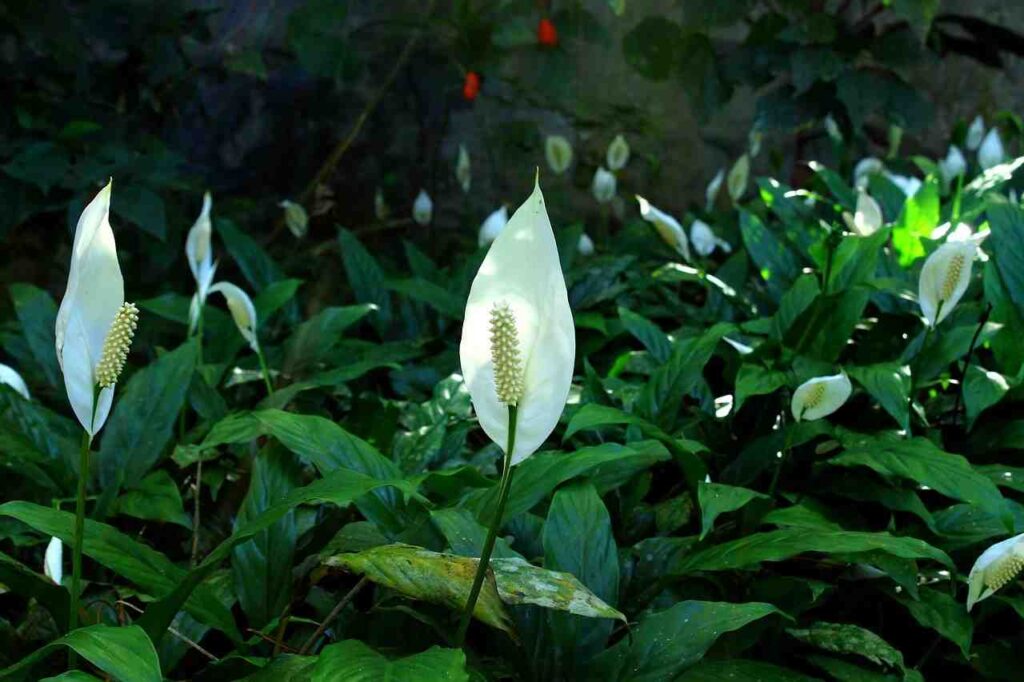Peace Lily Plant: Indoor Plant for Purity, Calmness & Air Quality
Peace Lily (Spathiphyllum) is one of the most popular and versatile indoor plants, celebrated for its glossy, deep green leaves and elegant white spathes (flowers). Beyond aesthetics, it has remarkable air-purifying properties, reduces indoor toxins, and creates a soothing atmosphere. Whether for apartments, offices, or large living spaces, Peace Lily is an excellent choice for both beginners and experienced plant enthusiasts.
Originating from tropical rainforests of Central and South America, Peace Lily thrives in indirect sunlight and humid conditions. It symbolizes peace, prosperity, and positive energy in Feng Shui, making it a meaningful addition to any home or office environment. Its ability to flourish in low-light conditions makes it ideal for interior spaces with limited natural light.
Key Benefits
Air Purification
NASA studies confirm that Peace Lily removes harmful chemicals such as formaldehyde, benzene, xylene, and ammonia, improving indoor air quality significantly.
Low Maintenance
Thrives in low-light and tolerates irregular watering; perfect for busy lifestyles.
Stress Relief & Mental Well-being
Indoor greenery reduces anxiety, enhances mood, and promotes focus and calmness.
Decorative Appeal
Glossy dark leaves with elegant white blooms complement modern and traditional interiors.
Feng Shui Symbolism
Represents purity, peace, and positive energy; often placed in bedrooms or offices to attract harmony.
In this comprehensive guide, we will explore the plant’s types, ideal placement, care routines, propagation methods, common issues, fun facts, air purification details, and frequently asked questions to help you maximize the beauty and benefits of Peace Lily in your home.
Popular Types of Peace Lily
Spathiphyllum Sensation
Tall, large leaves and frequent blooms; ideal for spacious living rooms.
Spathiphyllum Mauna Loa
Large, glossy leaves with continuous flowers; perfect statement plant for interior décor.
Spathiphyllum Wallisii
Compact size with delicate flowers; ideal for desktops and shelves.
Spathiphyllum Domino
Variegated leaves with unique white streaks; adds artistic touch to interiors.
Spathiphyllum Sweet Memory
Medium height, hardy, blooms profusely; great for apartments.
Ideal Placement
Living Room
Enhances décor, creates a calming environment, and purifies air for family areas.
Bedroom
Improves air quality for better sleep; symbolizes peace and tranquility.
Office Desk
Reduces stress, boosts focus, and improves productivity.
Bathrooms & Kitchens
Tolerates humidity and indirect light; adds greenery to functional spaces.
Low-Light Corners
Thrives in shaded areas; perfect for apartments or interiors with minimal sunlight.
Strategically placing your Peace Lily maximizes its benefits, combining aesthetic appeal with health advantages like air purification, humidity regulation, and stress reduction.
Peace Lily Care & Propagation
Detailed Care Guide
Light
Thrives in bright, indirect sunlight. Can tolerate low-light conditions but blooms may reduce.
Watering
Keep soil consistently moist but not soggy. Water when top 2 inches of soil are dry. Reduce watering in winter.
Soil
Well-draining potting mix enriched with organic matter; avoid compacted soil.
Temperature
Ideal range 18–28°C (65–82°F). Protect from drafts and sudden temperature changes.
Humidity
Prefers moderate to high humidity. Mist occasionally or place on humidity tray in dry climates.
Fertilizer
Use balanced liquid fertilizer once a month during growing season (spring & summer).
Pruning
Remove yellowing or damaged leaves. Cut spent flowers to encourage new blooms.
Pot & Drainage
Always use pots with drainage holes to prevent root rot.
Propagation Methods
Division
Carefully remove plant from pot, separate roots into sections ensuring each has leaves and roots, and replant in fresh soil.
Water Propagation
Small rooted offsets can sometimes be grown in water before transferring to soil.
Following proper care and propagation methods ensures your Peace Lily remains healthy, blooms consistently, and continues to improve air quality in your home.
Common Issues & Solutions
Yellowing Leaves
Overwatering or poor drainage — Reduce watering, repot in well-draining soil.
Drooping Leaves
Low humidity or irregular watering — Increase humidity, water consistently.
Brown Leaf Tips
Excess fertilizer or dry air — Reduce fertilizer, mist leaves occasionally.
Pests
Aphids or spider mites — Wipe leaves, use insecticidal soap if needed.
Fun Facts About Peace Lily
One of the top plants recommended by NASA for indoor air purification.
Can bloom indoors even with moderate sunlight if cared properly.
Symbolizes purity, peace, and prosperity in many cultures.
Flowers can last several weeks if maintained correctly.
Perfect for offices and bedrooms due to low-light tolerance.
Air Purification Facts
Removes indoor pollutants like benzene, formaldehyde, and ammonia.
Increases oxygen and reduces airborne allergens.
Supports mental clarity, reduces stress, and promotes calmness.
Conclusion
Peace Lily is a must-have indoor plant for improved air quality, aesthetic beauty, and a serene atmosphere. Its low maintenance, striking leaves, and elegant blooms make it suitable for homes, offices, and apartments. Strategic placement enhances décor, purifies air, and brings positive energy.
Frequently Asked Questions (FAQs)
How often should I water my Peace Lily?
Water when the top 2 inches of soil are dry; avoid overwatering.
Can Peace Lily grow in low light?
Yes, it tolerates low light but blooms may reduce.
Is Peace Lily safe for pets?
Mildly toxic if ingested; keep out of reach of cats and dogs.
How do I propagate Peace Lily?
Mainly through division; offsets can also be separated.
Why are my Peace Lily leaves yellow?
Usually due to overwatering or poor drainage.
Can Peace Lily bloom indoors?
Yes, with proper light and care, it can flower indoors.
Does it purify air?
Yes, Peace Lily removes common indoor toxins like benzene and formaldehyde.
How to improve blooming?
Provide bright indirect sunlight, proper watering, and occasional fertilizer.
Can it survive in apartments?
Yes, it’s perfect for indoor urban environments.
What temperature does Peace Lily prefer?
18–28°C (65–82°F) is ideal for growth.

